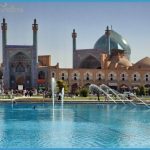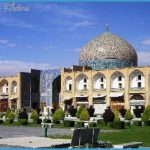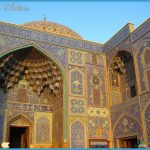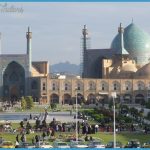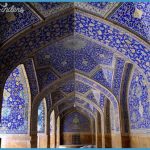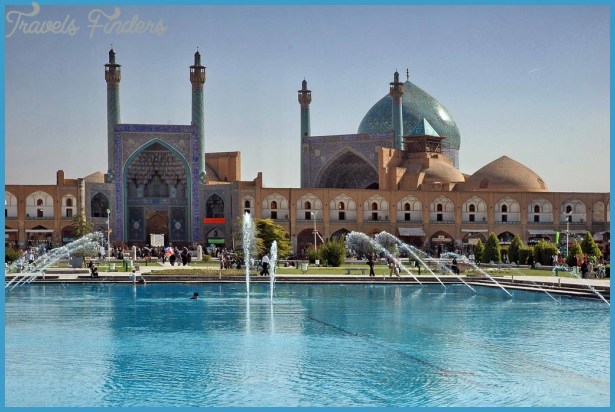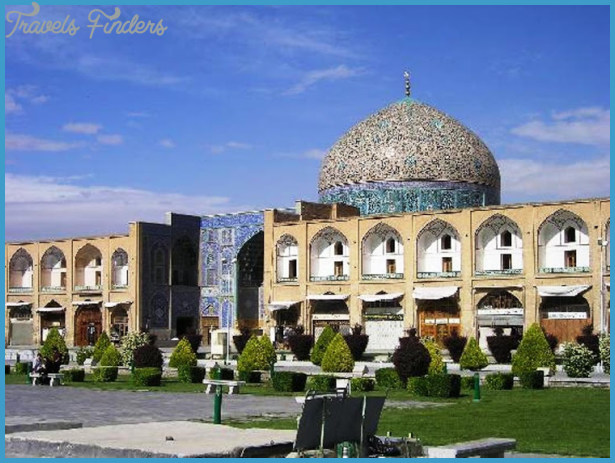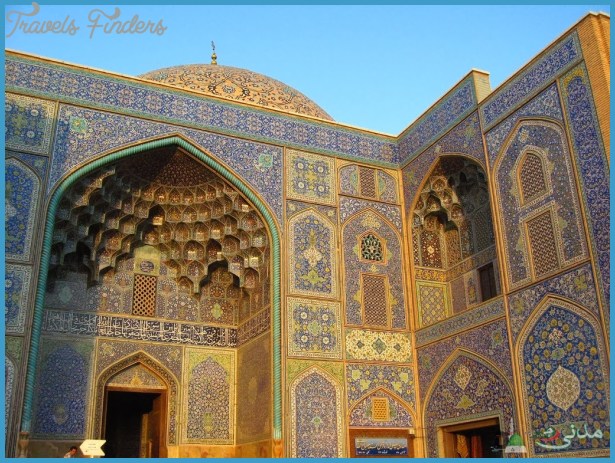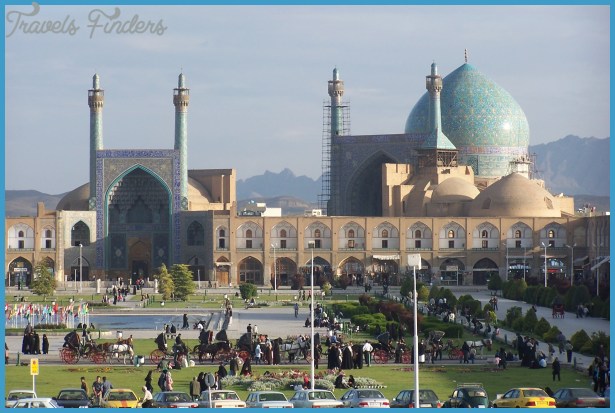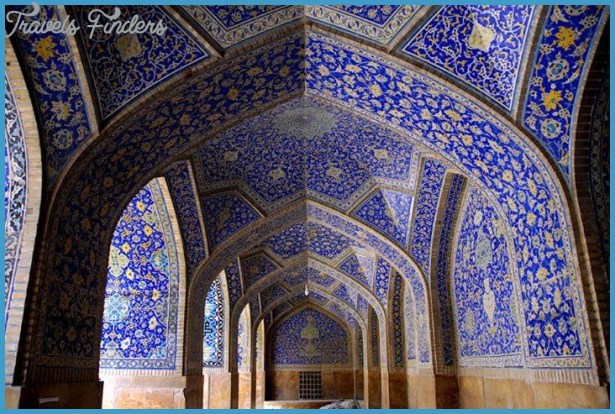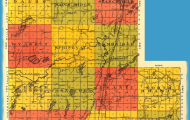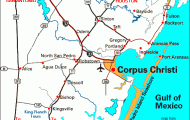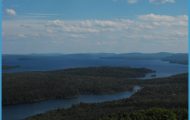OSTAD SHAYKH BAHAI
The soaring turquoise dome of its prayer hall and the intricate design of the tiled decoration are just two of the elements that make the Masjid-i-Shah one of the most beautiful buildings in the Islamic world. It was constructed during the reign of the powerful Safavid dynasty, whose huge empire centered on Persia (modern Iran). Their great ruler, Shah Abbas I, moved the Safavid capital to Isfahan and began a major rebuilding program with the Masjid-i-Shah as the city’s principal mosque, with a grand entrance on the south side of the new central square.
The Masjid-i-Shah is an outstanding example of Safavid architecture. Like most of the great mosques of the time, its prayer hall is roofed with a dome that covers a single huge space, in contrast to the prayer halls of the earliest mosques, which had a forest of pillars supporting the roof. As well as providing excellent acoustics, this spatial arrangement was practical, since it meant that the mosque could accommodate a large congregation, and it became popular in places where the resources were available to build a large dome. Masjid-i-Shah’s curving dome is also astonishingly decorative, with its covering of brightly colored tiles bearing stunning Islamic patterns.
The building has another key feature of a major Persian mosque-a large courtyard with several elaborate iwans (gateways). This courtyard plan was popular for large mosques, partly because it provided a place where members of the congregation could perform their ablutions before entering the prayer hall. The courtyard also provided scope for buildings leading off it, such as the religious school and winter prayer hall at Masjid-i-Shah. Throughout the complex the design of the details-especially in prominent parts of the building, such as the tops of the minarets and the iwans-is meticulous and reveals innovations in ceramic technology, such as the use of deep shades of brilliant color.
ON SITE
Shah Abbas I ruled Persia from 1587 to 1629. The most successful of the Safavid rulers, he reorganized the Persian government, creating a centralized administration in his new capital city, Isfahan. To make this a fitting center, Shah Abbas undertook an extensive building program with his architect and planner, Ostad Shaykh Bahai. The city was redeveloped around a vast central avenue and a large open space, Naqsh-e Jahan Square. The square was the site of the Masjid-i-Shah, the Ali Qapu Palace (the royal residence from which Shah Abbas governed and where he entertained visiting dignitaries), and the imperial bazaar, one of the biggest in the Islamic world. The mosque’s prayer hall faces Mecca. By arranging these key buildings around a square, Shah Abbas drew together his kingdom’s powerful institutions the monarchy, the merchants, and the clergy so that he could exercise control from a central point.
1 Setting The mosque is set at a 45-degree angle to the square.
Visual tour
1 ARCADE INTERIOR The arcades that run around the mosque courtyard are supported by the flattened arches that were popular in Islamic architecture. Their ceilings are vaulted in a star pattern, and both the ceilings and upper parts of the walls are covered in ceramic tiles. These sophisticated spaces were appreciated by worshipers they offered shade from the hot sun.
3 IWAN The four tall entrance gateways, or iwans, are among the most striking features of the courtyard. Each consists of a large pointed archway surrounded by walls that rise to form a rectangle and, in the case of the two iwans that lead to the prayer hall, are topped with slender minarets. Inside each opening is a vaulted space with intricate, stalactite decoration that contains the doorway.
1 COURTYARD On each side of the mosque courtyard an iwan is framed by rows of arches in a two-story arcade. This arrangement creates a satisfying symmetry that is reinforced by the patterns of the decorative tiles and the reflections in the central pool. The Safavids did not use minarets for the call to prayer. Instead, they built a goldast a small rectangular structure with a pyramidal roof on top of one of the iwans, and from here the muezzin would call the faithful
MASJID-I-SHAH IRAN 135
1 DOME INTERIOR The deep blues and golds of the dome’s glazed tiling give out a rich glow.
The architects made the transition from octagonal spaces to circular dome by building a series of triangles called squinches above the arches. These triangles are divided into a series of three-sided and diamond-shaped facets, and this treatment, together with the tile patterns, makes the structure appear much less massive. The builders found that such a space had excellent acoustics.
2 DOME EXTERIOR Persian architects were notable builders of domes and had used them to roof mosques since at least the 12th century. Masjid-i-Shah’s is one of the biggest and most decorative. It has a double-skin structure, the outer layer rising some 174ft (53m) and the inner dome about 46ft (14m) lower.
This method of construction allowed the builders to create the tallest dome in the city, while keeping the interior ceiling at a lower, more aesthetically pleasing level. On the outside the masonry drum on which the dome sets forms a horizontal band that is covered with ceramics bearing inscriptions from the Qur’an. The dome’s decoration consists of artistic, curling arabesque forms.
ON DESIGN
Colored ceramic tiles were widely used to cover walls and floors in western Asia even in pre-Islamic times. By the 13th century they were popular in Persia and the surrounding area, and Persian artists developed the use of tiled mosaics, cutting small cubes (tesserae) of tile and arranging them to make intricate patterns. By the 16th century, however, tiles painted in more than one color were popular, not only on account of the visual effects they created but also because applying colored glazes to a single tile before firing was faster than assembling patterns out of thousands of tiny tesserae. The Masjid-i-Shah’s tiles display an impressive color palette, with dark and light blues dominating, in combination with small areas of yellow, black, white, green, and beige.
1 Tiling detail
The patterns in this piece of vaulting show a skillful use of blue, white, and yellow in a flowerlike pattern that yields more and more detail when viewed closely.
4 MINARET Although not fulfilling the usual function of minarets, those at Masjid-i-Shah are prominent architectural features. Arranged on either side of the two principal iwans, they act as signposts to show worshipers the main route to the prayer hall and are covered in intricately patterned tiles. At the top each minaret broadens to accommodate a balcony, and this is supported by corbels treated in the multi-faceted stalactite form much favored by Safavid architects. The balustrade of the balcony, with its openwork pattern, is beautifully carved and finished.
1 MIHRAB A niche in one interior wall of the prayer hall (here the southwest wall), the mihrab indicates the direction of Mecca and therefore the way the congregation should face during prayers. As in most major mosques the mihrab at Masjid-i-Shah, with its multifaceted vaulting and rich blue-and-gold tiling, has been designed and decorated with great visual flair. Some of the tiles bear inscriptions, and sacred calligraphy runs vertically up and down the sides.

